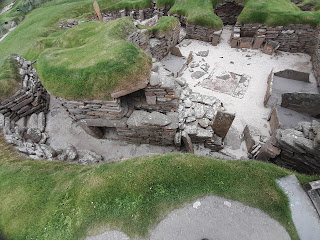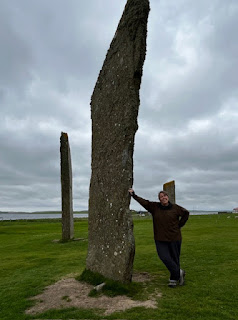Up bright and early this morning at 6.45am as we need to leave by 7.40am to queue for the ferry across to Orkney.
Had a pretty crappy nights sleep as this darn dry cough is soooo frustrating. I don't have a sore throat but am starting to bring up little bits of flem. The coughing lasts about 5 mins then stops just as quickly. I'll be grabbing some better medicine later today, in the hopes of killing the cough all together.
Overcast today, with a little light rain but Orkney isn't supposed to have any, so fingers crossed ✌. The ferry terminal is only a 5 min drive away and easy to find. We check-in and queue up with the other cars etc. It takes about 90mins to reach Orkney and whilst Sue goes outside to take some photos I stay warm inside and watch the NRL - Roosters V Sharks. Great way to kill the time.
Reasonably smooth crossing and before we know it are driving around Orkney to our first stop Skara Brae. Time for a history lesson.....
- Skara Brae is regarded as the best example of a Stone Age village in Northern Europe
- hidden from view until 1850, a great storm hit Orkney, and high winds and waves ripped turf from a small hill, known then as Skerrabra (now as Bay of Skaill) - revealing the hidden village under the sand
- after another storm in 1926, further excavations were undertaken and during the 1970's radiocarbon dating established the settlement was inhabited from about 3200 to 2200 BCE
- in 1999 Skara Brae was a key component in the awarding of UNESCO World Heritage status to "The Heart of Neolithic Orkney," as the islands are increasingly recognised for their part in the development of European life. The other sites which make up this 'Heart' are Maes Howe (a large chambered tomb) and two ceremonial stone circles - the Stones of Stenness and the Ring of Brodgar. We visited all three, so will provide more info further down this post
- the dwellings are built of undressed slabs of stone from the beach, without any mortar. Thankfully the drift sand that filled them immediately after their excavation preserved the walls in places to a height of eight feet
- there are no trees on the island, so furniture was made of stone and thus also survived
- the village consisted of several one-room dwellings, each rectangle with rounded corners, entered through a low, narrow doorway that could be closed by a stone slab
Walking around Skara Brae enables one to take a stroll 5,000 years back in time. Long before Stonehenge or even the Egyptian pyramids were built, the is corner of Orkney was home to a thriving village!!
They've recreated a house which allows you to enter and experience being inside a prehistoric home. You then take a short scenic path to the village where you peer down into the houses with their beds, dressers and firesides, all set out exactly as they would have been 5,000 years ago, providing a view of domestic Stone Age life.
Here's a view of the outside and inside of the recreated house:

After a short path walk we step back 5,000 years and see:
Situated beside Skara Brae is Skaill House. The location has been occupied since ancient times - it was the of Skaill House and farm who noticed the exposed stone, after the great storm of 1850, which led to the discovery of Skara Brae.
There is evidence of Pictish settlements - a Pictish burial ground lies under the foundations of the house and the work Skaill is derived from the Norse for "Hall," which suggests the location was important in Norse times too.
In 1620, Bishop George Graham contracted a manor house that is the central part of what is now Skaill House. The Bishop's original bed can still be seen at the house today - here tis:
In 1997, restoration work was completed and the property opened to the public. It is preserved as the family home it was in the 1950s, with Captain Cook's dinner set and Stanley Cursiter paintings hanging on the walls.
Here's the dining room, dinner set and some of the paintings:
I don't mind a spot of pink - but this classic 50's female bathroom is a bit over the top:
We are on a tight timeframe trying to fit in the five things we want to visit before catching the ferry back to Thurso. We are now one down.
Next stop is the Earl's Palace.
Robert Stewart was the illegitimate son of James V by his mistress Euphemia Elphinstone and half-brother to Mary Queen of Scots. He moved to Birsay (north of the Orkney mainland), and between 1569 and 1574 built the Earl's Palace. His nephew, James VI, named him Earl of Orkney, Lord of Shetland and Knight of Birsay in 1581.
The palace contained service rooms on the ground floor, while the upper floors, comprising two halls, chambers and a gallery, were reserved for the earl. By 1700 the palace had fallen into decay.
It still looks impressive:
Two down - next stop, lunch 🍝🐣. Finding somewhere to grab some take-away so we could keep to our tight schedule ended up being more problematic than expected. Ended up eating a steak pie that barely passed as edible, but it gave me something in my tummy 😳.
Number three - The Ring of Brodgar, one of Scotland's most famous monuments.
An almost perfect circle, at 5,500 square metres it is the largest stone circle in Scotland - and the third largest in the UK. The largest stone is four-and-a-half metres tall. The monument was built over 4,000 years ago. The stones were first quarried near the Skara Brae and then transported five miles/eight kilometres to the circle's site. Debate over the ring's original use still abounds.
Aligned to the equinox and solstice, was it an astrological calendar or a place of religious devotion and celebration? Perhaps both?
Number four - Stones of Stenness.
The area is also home to the Stones of Stenness - a smaller, though no less impressive group of monoliths, which have a claim to being one of Britain's oldest stone circles.
Our final stop before catching the ferry is Maeshowe Chambered Cairn. We meet at the Visitors Centre to catch a shuttle bus to it's location 5 mins down the road.
The Maeshowe is a chambered tomb - the finest Neolithic building to survive in north-west Europe. Built around 5,000 years ago, it is a masterpiece of Neolithic design and construction - not least because of its use of massive stones.
From the outside, Maeshowe looks just like a large grassy mound. The word 'howe' comes from the Old Norse for 'hill'. We enter it by stooping to walk about 10m to reach the central, stone-built chamber. Each wall in this passage is formed mostly of a single, gigantic sandstone slab up to three tonnes in weight. The floors, back walls and ceilings of the three side cells (off the central chamber) are also each made of single stone slabs.
Maeshowe appears to have been closed up for good after several hundred years of use as a burial tomb. Around 3,000 years passed before it was entered again by Norseman, who broke into the mound. The Norse left a fascinating legacy: light-hearted runic graffiti carved all over it's walls. It's the largest collection of runic inscriptions to survive outside Scandinavia and a powerful reminder that Orkney was under Norwegian rule until 1469.
We were not allowed to take photos inside, so this is the best we could get:
Fantastic day on Orkney as we head off to the terminal to catch our 4.30pm ferry that will drop us back in Thurso at 6.15pm.
We have a seafood dinner booked at a Restaurant only 5 mins from our accommodation. Great way to finish our fun packed day.
Tomorrow we are off to visit the Queen Mothers Castle Mey - can't wait.






























Comments
Post a Comment